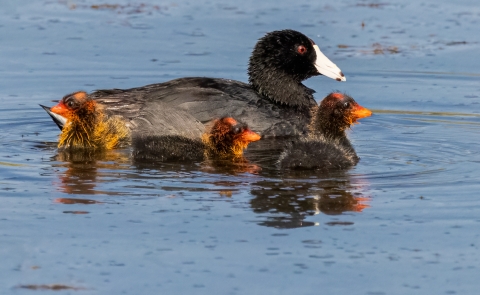Seasons of Wildlife
Ae‘o - Hawaiian stilt
The Hawaiian name for "one standing tall" aptly describes this black and white bird with its long, slender pink legs.
What do you hear as you get out of your car at the pond? A friend called them the “Chihuahua of the wetland” because of their constant vocalization chatter. Recognition, warning, whatever the purpose the ae‘o are the most prevalent of the endangered birds at Keālia Pond.
The ae‘o is a slender wading bird with black coloration extending from the forehead down the back of the neck and throughout the back. White covers the front of the face, down the front of the neck and underbelly. Their pink, long legs are almost as long as the bird’s body and are one of their identifying features. Females have a tinge of brown on the back whereas the back of males is black. The long legs and long bill allow the stilt to wade into the water further than other common shorebirds at Keālia Pond.
Ae‘o prefer shallow water no more than seven inches in depth. Nesting sites are on exposed mudflats and low islands with adjacent water (fresh, brackish, or salt water) and vegetation. Nests are either made from a pile of sticks or just a shallow nest depression on the ground.
The onset of ae‘o breeding season is when water level in the ponds recede and mudflats are exposed, usually in late March-early April at Keālia Pond NWR. Nests consist of vegetation material with a depression in the middle or just a depression in the soil. Four brown speckled eggs are laid and incubated approximately 24 days. Ae‘o chicks are precocious – once hatched they are mobile and feeding on their own, but under the watchful eyes of their parents. Chicks resemble their eggs with brown and off-white speckles until they obtain feathers similar to the adults. Breeding season, including chick fledging, is completed by mid August.
Movement of ae‘o between wetlands on Maui and other islands are known from sightings of color-banded birds. Ae‘o are vocal even during the nonbreeding season. They actively defend their nests and chicks with calls and dive-bombing to detract the predator or disturbances. Upon threat of predators or humans, adults vocalize to warn chicks who in turn will crouch down and remain motionless, using their camouflaged down to blend with the ground.
The ae‘o are the most vulnerable to nonnative mammalian and avian predators (cattle egrets) and are easily disturbed by human activities. During breeding season at Keālia Pond (April to July) areas of the Kanuimanu Ponds may be inaccessible to the public to allow birds to successfully incubate and raise their chicks.
‘Alae ke‘oke‘o- Hawaiian coot
The coot can be recognized by its white bill and frontal shield which contrasts with its dark body. Called “mudmuckers” in the southern states, these birds are visible whether water is low or high.
The ‘alae ke‘oke‘o is dark slate gray with a white bill and a large frontal shield (extension of bill onto forehead). The frontal shield is white but some sport a small red dot which is not related to sex or age. They have white undertail feathers that are visible when adults are defending their territory and during courtship displays.
‘Alae ke‘oke‘o are found in fresh and brackish-water marshes and ponds. They rarely fly, but are capable of sustained flight close to the water. ‘Alae ke‘oke‘o can be observed throughout the year even when water level is low. During breeding season (December to March) they prefer deeper water (up to 18 inches in depth) interspersed in emergent vegetation which provides the vertical structure needed to construct nests. The vegetation also provides cover for young birds.
The ‘alae ke‘oke‘o is dark slate gray with a white bill and a large frontal shield (extension of bill onto forehead). The frontal shield is white but some sport a small red dot which is not related to sex or age. They have white undertail feathers that are visible when adults are defending their territory and during courtship displays.
‘Alae ke‘oke‘o are found in fresh and brackish-water marshes and ponds. They rarely fly, but are capable of sustained flight close to the water. ‘Alae ke‘oke‘o can be observed throughout the year even when water level is low. During breeding season (December to March) they prefer deeper water (up to 18 inches in depth) interspersed in emergent vegetation which provides the vertical structure needed to construct nests. The vegetation also provides cover for young birds.
Featured Species
Keālia Pond National Wildlife Refuge is valuable for its endangered ae‘o (Hawaiian stilt) and ‘alae ke‘oke‘o (Hawaiian coot), providing nesting, feeding and resting habitat. The wetland refuge is one of the top three most important locations for supporting the needs of Hawaii’s endangered wetland birds in Hawaii.


